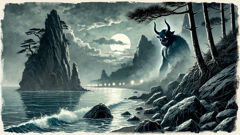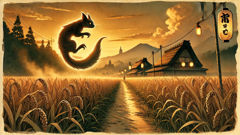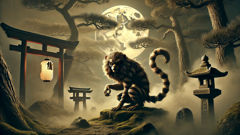Introduction
When twilight gathers and the rice paddies hush, villagers still say you can hear the whisper of an old cart wheel before you see it: the scrape that sounds like a memory trying to drag itself back into daylight. The Wanyudo—wheels of flame that bear a human face, mouths agape as if to call for help—has rolled through Japan’s tales since at least the medieval highways, and its image lodged in the collective imagination like a splinter. Seeing a Wanyudo is more than seeing a ghost; it is a confrontation with a shape that combines machine and man, fire and face, freight and punishment. Many stories tie its origin to the hellish process of transporting the condemned, or to a cruel lord whose cruelty tethered a living soul to wood, iron, and flame. Others speak of the wheel as an omen, a warning that invites pity and fear in equal measure: those who look directly into the tormented visage are said to lose their own calm, to be pulled into nightmares, to see the world through charred eyes for days. The Wanyudo's paradox is part contraption, part victim—so it intrigues the scientist in us and terrifies the tender-hearted. In this narrative I weave together historical echoes, eyewitness threads, and cultural reflections. We'll travel muddy lanes and lantern-lit inns, eavesdrop on elders with hollowed voices, and linger where shadow clings to stone. Along the way we'll meet the faces in the flame—some human, some hinting at darker debts—and trace how a single terrifying yōkai came to carry the weight of communal memory. This introduction is an invitation and a caution: read on, but remember that folklore is porous; the more attention you give a story like this, the more it takes root in your own nights.
Origins, Old Roads, and Whispered Names
The earliest echoes of the Wanyudo belong to the iron-scented world of medieval highways, where trade caravans and punishments shared the same lanes. Towns grew around waystations, and travelers spoke to one another in low tones about the things best left to lanternlight. When priests recorded unusual phenomena or when village elders warned children away from the roadside after dusk, they often described a cart wheel that burned without consuming the axle that held it, a wheel rimmed in blue-flame while its face at the hub seemed human, sometimes regal, sometimes pauper, always aching.
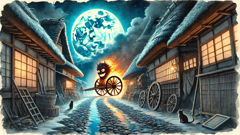
One theory—rooted in the moral topography of Buddhist and Shinto beliefs of the period—tied the Wanyudo to the idea of karmic remnants. When a person died in shame or by cruel injustice, their suffering might coalesce into a visible form that refused to rest. Objects involved in the wrong—chains that choked, blades that fell, wheels that rolled away laden with stolen grain—could inherit the weight of those deeds. The Wanyudo, in this reading, was a boundary creature: neither entirely dead nor fully alive, a fragment of a human future that had snapped off and lodged itself within a wheel. There are records—fragmented, translated from temple registries and copied into household notebooks—mentioning punishments where condemned men were paraded before crowds, bound to carts as spectacle. Whether those lists inspired the legend or whether later storytellers retrofitted the images to moralize misconduct remains difficult to untangle.
Another strand of origin lies in the visual language of roadside apparitions. Japan’s landscape is dotted with wayside statues, komainu guardians, and small shrines dedicated to travelers and lost souls. The Wanyudo embodies a potent visual metaphor: a face trapped where a wheel should be suggests loss of agency, the reduction of a person to a tool. It is a visual shorthand for dehumanization. When local chronicles spoke of unnatural fires that refused to char straw or wooden beams, villagers linked the occurrence to resentments burned into the landscape—resentments that took the shape of a wheel that rolled with a man's face silhouetted against the light.
Yet the penchant for faces in folklore runs deeper. Across cultures, faces provide focus for empathy; they allow observers to invest whole narratives in a glance. The Wanyudo's face is often described as mouth-open, eyes hollow, hair pinned with ash. Some accounts say the face looks recognizably human to those who knew the dead man—family members who swore later that the contorted features matched a beloved relative or a hated official. In one Edo-period diary, an innkeeper wrote of a weeping woman who claimed the Wanyudo showed the face of her own husband, wronged and murdered in a tax dispute. She followed the wheel's path and found, by a mossy milestone, his wife's comb. The wheel did not stop; only the memory lingered.
These origin stories all fold together into a myth that is elastic. For some, Wanyudo represents punishment—a punitive spirit dragging a face of the condemned through the world as a warning. For others, it is the opposite: a trapped victim, forever seeking relief and recognition. The ambiguity is key; it allows the Wanyudo to appear in the moral imagination wherever a community feels guilt, fear, or unresolved loss. The wheel's persistent image—flames licking a carved face, fire that spares the wheel's spokes—reminds listeners that objects can bear witness and that the boundary between animate and inanimate is porous when human anguish is involved.
The Wanyudo is also linked to hellish processions. In oral tales told near hearths, elders spoke of the wheel rolling across toll bridges and crossroads: where it passed, frogs went silent and dogs whimpered. Sometimes it was a herald of other spirits, a leader of a spectral convoy. In some late-Heian texts that scholars debate, wheels and carts appear in processions escorting the dead; the Wanyudo may be an individuated figure from that broader cosmology, the emblematic wheel worn by a particularly noisy, unforgettable ghost. In these retellings, the wheel is a siren that draws unwary eyes; viewers are punished not by the wheel directly but by their own curiosity.
Even images of Wanyudo have changed with time. Woodblock prints from the Edo era present it with exaggerated features suitable for public consumption: a theatrical face, precise teeth, flames rendered with stylized swirls. Later naturalistic paintings try to soften the grotesque with mood, lighting, and pastoral setting, making the Wanyudo less a caricature and more an elegy. The story's persistence stems from this elasticity: the Wanyudo can be sharpened into a warning against cruelty, softened into a tale of loss too heavy to be buried, or presented as a lurid attraction at curious inns for merchants with coin.
What ties all variations together is the scene: a wheel that burns with unnatural flame, a human face at its heart, and the sound—the scrape and the whisper—that unsettles those near it. The story calls to witness, and the witness often becomes part of the folklore. People who saw the Wanyudo told different tales, but all left the same impression: this was not just spectacle but demonstration. The wheel announced a break in ordinary order, a wound in the landscape where a story remained open.
Image:
Encounters, Omens, and the Wheel's Sayings
Accounts of encountering the Wanyudo vary like the landscape they traverse—marsh, mountain pass, village road—but they share a single, persistent detail: the wheel appears at the threshold between movement and stillness. Many witnesses describe the moment of first perception as the air changing: wind drops, frogs stop, distant voices fade to paper. The wheel's approach is often heralded by the faint scent of scorched paper and old incense, as if the past itself were burning softly. Those who have written their encounters in journals—farmers who carved their names into door jambs, noodle sellers who kept accounts by night—report that seeing the Wanyudo is as much a sensory cascade as a vision: heat on the skin though the air is cold, the sound of a wooden axle scraping stone, a face in the hub that seems to breathe its own wind.
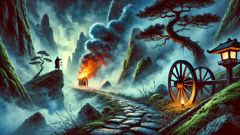
One farmer who lived near a long blind bend on an old trade road wrote that he encountered the wheel on two different autumn nights. The first time, he turned his cart to avoid what he thought was a trick of moonlight and almost ran into a mossy milestone. The wheel flashed by with a noise like a thousand bees, and when it passed the fields looked scorched though morning found no trace. The second time, the wheel spoke—not in words but in a single, terrible expression at the face: a pleading that seemed aimed at the farmer's eyes alone. That look haunted him. For months afterward, he found his hands trembling when he chained his oxen and often dreamed of his own reflection turned into iron and flame.
An innkeeper near a fog-locked pass recounted a different kind of encounter. On a night when a merchant's party had been beset by bandits, she saw the Wanyudo roll past the open door. Through the wheel's face she glimpsed scenes—flashes of the merchant's life, acts of small kindness and a moment when he had signed away a peasant's small claim to land. The innkeeper later believed the wheel was showing memory like a lantern, a moral inventory. The merchant, unsettled, returned the deed to the peasant and never left that village again. Whether the wheel forced confession or merely shone a light on conscience is unclear, but the event became local legend. The wheel functioned as an external conscience in the narrative: a painful, inexorable mirror.
Others emphasize the wheel's agency. In one provincial tale, a highwayman rushed to the roadside to claim the wheel's face as that of a rival who had betrayed him. The thief's breath became shallow, his hands burned as if holding embers, and he dropped to his knees sobbing, swearing to change. Sometimes the wheel is revenge, sometimes it is a call for restitution. The variation speaks to how communities use myth to mediate justice: when the formal systems fail, a story like the Wanyudo can offer symbolic retribution.
Then there are accounts suffused with grief. A mother, having lost a son to conscription long ago, swore she saw the wheel bearing his face as he once sat at their low table, hair still soft and unscarred. Her neighbours thought the sighting a manifestation of grief: a private sorrow given public form, an image the village tolerates because it protects the vulnerable from forgetting. Rituals grew up around such sightings. Families would leave offerings at the road—rice cakes, a small bowl of sake—hoping the wheel would recognize the token and pass without harming them. Shrines at crossroads often bear votive tablets with sketches of wheels or faces, crude drawings that collect a small people's imaginings, enhancing the sense that the Wanyudo is something to placate rather than a monster to slay.
People also turned the Wanyudo into a living measure of social wrong. When a landlord took extra grain during a bad famine, villagers might say the Wanyudo would come to wake him in the night. Murders whispered into the dark were said to attract the wheel; cowards who sold their neighbours out to authorities imagined it would roll by, showing them what they had lost. The wheel's face could be sympathetic or accusatory. In such stories, the Wanyudo is less an agent of random terror than a narrative device that embodies public conscience. It gives moral language to misfortune and a masked means of speaking truth when direct speech would be dangerous.
Yet the wheel also frightens because of the contagious effect of gaze. Many accounts punish the onlooker. Those who stare into the flame-face are described as returning with eyes rimmed in red, or with dreams they cannot dismiss. A teacher in a mountain schoolhouse once told students that he had looked too long at the Wanyudo and found himself seeing people as wheels—reduced and rolling—until the sight went in time. The idea that seeing reshapes perception is fundamental: the Wanyudo operates as a test of humanity's ability to endure truth. To look is to risk transformation; to look away is to risk repression.
The Wanyudo's place in ritual practice is complicated. Some communities made offerings to quell sightings; others used the tale to enforce social norms. In Edo parodies and plays, the wheel becomes a stage device—part horror, part comic relief—allowing audiences to be both frightened and relieved. The theatrical Wanyudo comforts by being contained; the roadside Wanyudo terrifies because it refuses containment. In modern retellings, urban legends have migrated the wheel into new settings—subway tunnels, highways—transforming its symbolism but not its function. When a town experiences a sudden, inexplicable fire, someone will quip that the Wanyudo has come through town. The wheel's adaptability is why the story hasn't died: it fits new anxieties as they arise.
At heart, these encounters and omens are not simply about spectacle. They are about how communities remember and reckon with harm. The Wanyudo is a rolling archive; it preserves a face and a story by forcing it to move through time and space. Each sighting adds a line to the ledger of a village's conscience, and each hush that follows its passage is a page turned. For listeners today, the myth endures because it addresses a perennial question: how does a society bear the memory of wrongdoing without being consumed by it? The Wanyudo offers a haunting answer: memory becomes motion, and motion becomes flame.
Image:
Conclusion
The Wanyudo survives because it fills a hole in communal ethics—a wheel that carries not only a face but also the collective weight of unspoken guilt, loss, and the need for acknowledgment. Whether seen as punishment, victimhood, or a moral mirror, the Wanyudo confronts us with a simple, stubborn fact: stories inherit the stains of history. When a community chooses to remember wrongs, to tell them around hearthfire and threshold, a tale like this can keep a wound from closing over in silence. In modern nights the image persists—the wheel reimagined on pages, in art, and in the whispered lore parents tell children who wander near old roads. It is a cautionary image, yes, but also a compassionate one: the face in the flame invites a kind of recognition that formal justice sometimes fails to grant. To listen is not merely to be afraid; it is to be willing to hold discomfort, to permit a public memory its shape. And perhaps that is the Wanyudo’s final gift: an insistence that certain losses keep turning until someone looks, and in looking, decides to act differently. If the wheel ever stops, it will be because a community has answered the face with restitution, remembrance, and care—settling the embered ledger until the night again breathes steady air.


